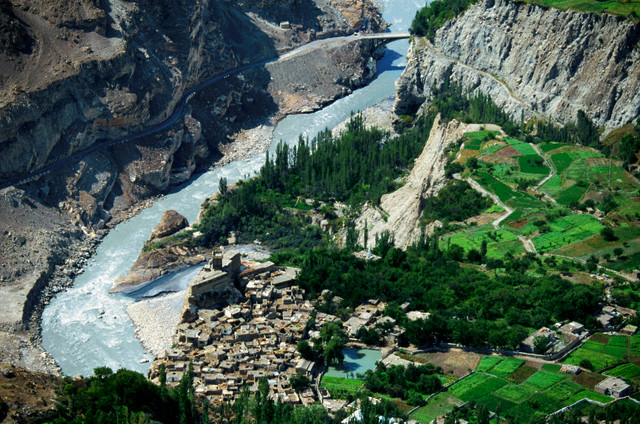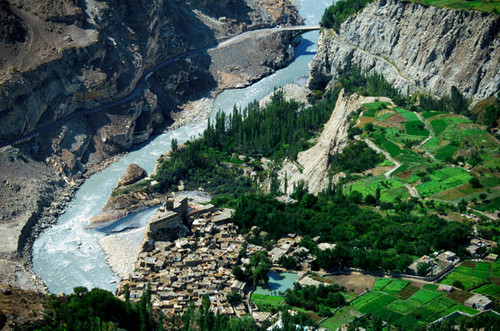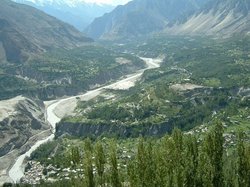MAJOR ATTRACTIONS
MOUNTAINS
Tourist Attraction |
Pakistan is a destination of special interest for travelers and tourists. Its main attractions include adventure tourism in the Northern Areas, cultural and archaeological tourism as found at Taxila, Moenjodaro, Harappa, Swat, along the Karakoram Highway and early Muslim and Mughal heritage of Multan, Lahore, Thatta and Peshawar. From the mighty Karakorams in the North to the vast alluvial delta of the Indus River in the South, Pakistan remains a land of high adventure and nature. Trekking, mountaineering, white water rafting, wild boar hunting, mountain and desert jeep, Camel and Yak safaris, trout fishing and bird watching, are among the few activities that entice the adventure and nature lovers to Pakistan. |
Northern Pakistan
Northern Areas of Pakistan, spread over 72,496 sq. km are the most fascinating regions of natural beauty. Amidst towering snow-clad peaks with heights varying from 1,000 to 8,000 m, the valleys of Gilgit, Hunza and Baltistan recall Shangri-La. The cultural patterns of these regions are as interesting as their geography. The people with typical costumes, folk dances, music and sports like polo and buzkashi, provide the tourist an unforgettable experience. Nowhere else in the world is such a great concentration of high mountains, peaks, glaciers and passes except in Pakistan. Of the 14 over 8,000 meters high peaks on earth, 04 occupy an amphitheater at the head of Baltoro glacier in the Karakoram range. These are; K-2 (8,611 m, world’s second highest), Gasherbrum-I (8,068 m), Broad Peak (8,047 m) and Gasherbrum-II (8,035 m). There is yet another which is equally great, Nanga Parbat (8,125 m), located at the western most end of the Himalayas. In addition to that, there are 68 peaks over 7,000 m and hundreds others over 6,000 m. Northern Pakistan has some of the longest glaciers such as Siachen (74 km), Hispar (59 km), Biafo (59 km), Baltoro (58 km) and Batura (52 km) outside the Polar region.
The Northern Areas of Pakistan, which is endowed with most unique geographical feature in the world. It is here that the three great, lofty and spectacular mountain ranges, Karakoram, Himalayas and Hindukush meet. In an area of about 500 kms in width and 350 kms in depth, is found the most dense collection of some of the highest and precipitous peaks in the world, boasting more than 700 peaks above 6000 meters and more than 160 peaks above 7000 meters. These include five out of the total fourteen above 8000 meter high peaks on earth, namely the second highest rock pyramid - the K-2 (8611m), the Killer Mountain Nanga Parbat (8125 m), the Hidden Peak Gasherbrum-I (8068 m), Broad Peak (8047 m), and Gasherbrum-II (8035 m).
The Hindukush is also a mountain vastness containing hundred of peaks, many above 7000 meters including Trichmir (7708 m) which is the highest peak of the range. The western bastion of the Himalayas range is Nanga Parbat, once dreaded as the "Killer Mountain”, but climbed many times by various expeditions since first disasters.
This enormous mountains wealth makes Pakistan an important mountain country offering great opportunities for mountaineering and mountain related adventure activities. The area is aptly called a paradise for mountaineers, adventure seekers and nature lovers. The compelling charm of these high, challenging, endless sea of rugged rock and ice pinnacles lure large number of climbers and trekkers from all over the world to the Northern Areas of Pakistan, each year.
The best climbing season is from the mid of May to end of September each year. However, climbing is possible in winter season also.
You will be pleased to know that the 50% concession in royalty fee granted to climbing expeditions during 2002-2005 will now continue into 2006 also. The status of 6500m peaks as trekking peaks will also remain applicable during the year 2006.
We are very glad to inform that the Government of Pakistan in continuation of the ongoing Tourism friendly policy has decided that only 10% royalty fee taken for mountains situated in Chitral, Gilgit and Ghizer to attract the climbers, trekkers and adventure lovers to less-frequented areas. We assures you of more good news to follow in coming months and hopes that many of Climbers, Trekkers and adventure seekers from all over the world will take full advantage of these incentives during the year 2007. Wishing a great adventure season in 2007
The Silk Route
For centuries, the Silk Route remained the main trading route between the South Asia and the Central Asia. After the completion of the Karakoram Highway (KKH) in 1978 along the same route, joining Pakistan with Chinese Muslim autonomous region of Xinjiang, the ancient trade link has been revived. The KKH has provided a great opportunity for international travellers to explore the un-spoilt natural beauty, unique culture and ancient traditions of Northern Pakistan together with other Silk Road countries like China, Kyrgyzstan, Tajikistan, Kazakhstan and Uzbekistan.
InValley Civilization
dus The Indus Valley Civilization was at its peak from the 3rd till the middle of the 2nd millennium BC. Discovered in 1922, Moenjodaro was once a metropolis of great importance, forming part of the Indus Valley Civilization with Harappa (discovered in 1923) Kot Diji and Mehrgarh (discovered in 1984).
Moenjodaro is considered as one of the most spectacular ancient cities of the World. It had mud baked bricks buildings, an elaborate covered drainage system, a large state granary, a spacious pillared hall, a College of Priests, a palace and a citadel. Harappa, another major city of the Indus Valley Civilization, was surrounded by a massive brick wall fortification. Other features and plan of the city were similar to that of Moenjodaro. The Kot Diji culture is marked by well-made pottery and houses built of mud-bricks and stone foundations.
Mehrgarh, the oldest Civilization (7,000 B.C), remains of which were discovered in the district Kachhi of Balochistan in 1984, was the pioneer of the Indus Valley Civilization. The evidence of crop cultivation, animal husbandry and human settlements have been found here. The inhabitant of Mehrgarh were living in mud-brick houses and learned to make pottery around 6,000 B.C.
Gandhara Civilization
Gandhara region the hallowed centre of Buddhism, had once been the cradle of the world famous Gandhara art, culture and knowledge. The archaeological remains found in Taxila, Peshawar, Charsadda, Shahbaz Garhi, Jamal Garhi, Takht Bahi, Swat and rock carvings along the ancient Silk Road (KKH) have well recorded the history of Gandhara.
Lying in Haro river valley near Islamabad, Taxila, the main centre of Gandhara, is over 3,000 years old. Taxila attracted the attention of the great conqueror, Alexander in 327 B.C., when it was a province of the powerful Achaemenian Empire. It later came under the Maurian dynasty and reached a remarkable matured level of development under the great Ashoka. Then appeared the Indo-Greek descendants of Alexander’s warriors and finally came the most creative period of Gandhara. The Kushan dynasty was established in about 50 AD. During the next 200 years, Taxila, Peshawar and Swat became a renowned centre of learning philosophy, art and trade. Pilgrims and travellers were attracted to Gandhara from as far as China and Greece. In 5th century AD, the White Huns snuffed out the last of the successive civilizations that held unbroken sway in this region for several centuries.
Early Muslim and Mughal Heritage
Pakistan is a treasure-house of Muslim art and architecture. Lahore, the cultural capital of Pakistan, is situated along the bank of River Ravi . The city has witnessed the rise and fall of many dynasties like Ghaznavids (1021-1186 AD), Ghoris (1186-1202 AD) and Slaves (1206-1524 AD) before arrival of the Mughals. The city was conquered by Babur of Ferghana (situated in Uzbekistan), the founder of the Mughal dynasty (1524-1764 AD). All the important monuments like the Royal Fort, Badshahi Mosque, Wazir Khan’s Mosque and Tombs of Empror Jehangir, Asif Khan, Queen Noor Jehan and the Shalimar Gardens, Hiran Minar etc., were constructed during this period.
On the other hand, the shrines, mosques and forts located in and around Multan and Bahawalpur are the master pieces of the early Muslim architecture. Some important buildings are; Forts at Multan and Derawar (Bahawalpur), shrines of Shaikh Bahauddin Zakaria, Shah Rukan-e-Alam, Hazrat Shams Tabrez at Multan and Tomb of Bibi Jiwandi at Uchh Sharif near Bahawalpur. The tombs at Chaukundi, 27 km out of Karachi, the remains at Banbhore (64 km from Karachi) and the largest necropolis of the world with a million graves scattered over an area of 10 sq. km on Makli Hills near Thatta together with the Shahjehan Mosque of Thatta, are exquisite specimens of Muslim architecture, with stone carving and glazed tile decorations.
Valleys of the Himalaya and the Hindukush
The Murree Hills and the Gallies, 55 km from Islamabad, at an altitude of 2,286 m are the most popular summer resorts in Pakistan. With a perfect Himalayan atmosphere and equipped with all modern facilities like good communication network, resort hotels, golf course and chair-lift/cable cars, Murree and Gallies are a wonderful retreat from the hot weather of the plains in summer. A holiday in Kaghan Valley, the Himalayan hide-away in the North West Frontier Province,(NWFP) is an un-forgettable experience. Its peaks, dales, lakes, water-falls, streams and glaciers are still in an unbelievable pristine state. The valley extends for 155 km rising from an elevation of 2,134 m to its highest point, the Babusar Pass, at 4,173 m.
The lush green valley of Swat, has a rich historical past. This is “Udyana” (the garden) of ancient Hindu epics; the land of enthralling beauty, where Alexander of Mecedonia fought and won some of his major battles. This is the “valley of the hanging chairs” as described by famous Chinese pilgrims, Fa-Hien and Hsuan Tsang in the 5th and 7th centuries.
Azad Kashmir rivals the Kaghan and Swat valleys in natural beauty. It extends from the plains of Mirpur at the northern edges of the Punjab through the outlyng foothills of the Haimalayas, to the mountains in the north at 6,000 meters above sea level. It is blessed with three major rivers, the Jehlum, the Neelum and the Poonch. Chitral valley is like a crown on the Hindukush Mountains with its high peaks, green pastures and unique culture. Chitral has attracted mountaineers, trekkers, naturalists and anthropologists alike. One of the major attractions of Chitral are the Kalash valleys - the home of the Kalash “wearers of the black robes”, a primitive pagan tribe.
Rivers
The Indus River is the lifeline of Pakistan. Without the Indus and its tributaries, the land would have turned into a barren desert long ago. The Indus originates in Tibet from the glacial streams of the Himalayas and enters Pakistan in the northeast. It runs generally southwestward the entire length of Pakistan, about 2,900 km (1,800 mi), and empties into the Arabian Sea. The Indus and its tributaries provide water to two-thirds of Pakistan. The principal tributaries of the Indus are the Sutlej, Beâs, Chenâb, Râvi, and Jhelum rivers. In southwestern Punjab Province these rivers merge to form the Panjnad (“Five Rivers”), which then merges with the Indus to form a mighty river. As the Indus approaches the Arabian Sea, it spreads out to form a delta. Much of the delta is marshy and swampy. It includes 225,000 hectares (556,000 acres) of mangrove forests and swamps. To the west of the delta is the seaport of Karâchi; to the east the delta fans into the salt marshes known as the Rann of Kutch.
| TRAILS & ROUTES | |||||||||||||||||||
|
Targeted Activities | Camping, Fishing, Hiking, Ice Climbing, Kayaking, Mountain Biking, Mountaineering, Rock Climbing |
Season Availability: | May to October |
Altitude: | 3000-8611 meters |
| Camping: | Allowed |
| Rescue Services: | Mountain Rescue Services Present with Helicopter Evacuation |
Green Meadow
A view of 900 year old Altit Fort
FAMOUS GLACIERS OF PAKISTAN | |||
Glacier | Region | Length in Kilometers | Area in Sq. Km |
Siachen | Karakoram (Baltistan) | 75 | 1,180.00 |
Biafo | Karakoram (Shigar) | 68 | 625.00 |
Baltoro | Karakoram (K-2) | 62 | 755.00 |
Batura | Karakoram (Hunza) | 58 | 290.00 |
Hisper | Karakoram (Nagar) | 53 | 620.00 |


